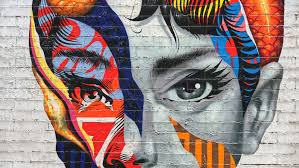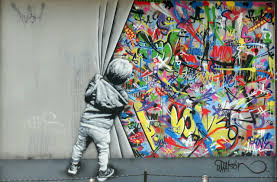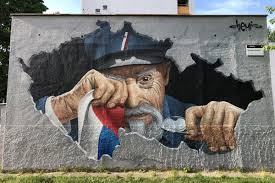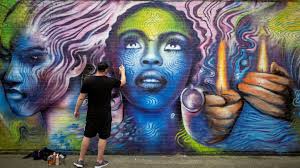Introduction: Beyond Vandalism, Towards a Global Movement

This Site was Written and Sponsored by Slot Gacor
The urban landscape is no longer just a canvas of concrete and steel; it has been transformed into a vibrant, open-air gallery by a daring group of individuals. These are the street art artists, the visionaries who challenge our perceptions of public space, beauty, and social commentary. Once dismissed as mere vandals, these creators have propelled their craft from the fringes of illegality to the prestigious halls of global museums and galleries. This article delves deep into the world of these modern-day artisans, exploring their motivations, their diverse techniques, and the indelible mark they leave on cities worldwide. The journey of street art artists is one of rebellion, talent, and an unyielding desire to communicate directly with the public, bypassing traditional artistic gatekeepers. They are the storytellers of the city, and their murals are the pages upon which these stories are written for all to see.
The evolution of street art from subculture to mainstream phenomenon is a testament to the power and persistence of these artists. What began with simple tags and throw-ups in the 1970s and 80s has blossomed into a complex and multifaceted art form encompassing stencils, wheatpastes, installations, and massive, photorealistic murals. The work of pioneering street art artists has forced a global conversation about the nature of art, ownership of public space, and the role of the artist in society. They operate in the liminal space between public and private, legal and illegal, temporary and permanent, creating a dynamic and ever-changing visual dialogue on our city walls.
Understanding this movement requires looking past the spray paint and into the minds of the creators themselves. Who are these street art artists? What drives them to risk legal repercussions to share their work? How do they develop their distinctive styles, and what impact does their work have on the communities they adorn? This comprehensive exploration will answer these questions and more, celebrating the skill, courage, and creativity of the individuals who have turned the world’s streets into their studio. We will trace the history of the movement, profile its most influential figures, and examine the techniques that define this powerful form of public expression.
The Historical Roots: From Cave Walls to City Walls
The impulse to mark public surfaces is as old as humanity itself. One could argue that the earliest street art artists were the prehistoric humans who painted on cave walls in Lascaux and Altamira. These ancient creators used the materials available to them to document their reality, tell stories, and express their beliefs, much like their modern counterparts. The desire to leave a mark, to say “I was here,” is a fundamental human trait that connects us across millennia. While the contexts and tools have dramatically changed, the core impulse remains strikingly similar: to communicate visually within a shared public realm.
The direct precursor to contemporary street art is the graffiti subculture that exploded in New York City and Philadelphia in the late 1960s and 1970s. Fueled by the availability of affordable spray paint, young people began “tagging” their names on subway cars and walls. This was not initially about creating art for art’s sake; it was about claiming identity and territory in a vast, often anonymous urban environment. Early pioneers like TAKI 183 and CORNBREAD demonstrated how a simple name, repeated enough times in enough places, could achieve a form of fame and notoriety. These early writers were the foundational street art artists, establishing the ethos of self-promotion and territorial marking that would define the movement’s early years.
As the graffiti movement evolved, so did its complexity and ambition. Tags became more elaborate, evolving into “throw-ups” and large, colorful “pieces” (masterpieces). The competition for fame and style pushed street art artists to innovate, developing new lettering styles, color combinations, and techniques for painting quickly and effectively in high-risk environments. The subway cars of New York became rolling canvases, carrying the art—and the names of the artists—to every corner of the city. This era laid the crucial groundwork for the diversification that would follow, setting the stage for the emergence of street art as a distinct but related discipline focused more on imagery, symbolism, and communication with a broader public.
From Tags to Masterpieces: The Evolution of Techniques

The toolkit of the modern street art artists is vast and varied, reflecting a constant drive for innovation and expression. The most iconic tool remains the spray can, which offers unparalleled speed and the ability to create smooth gradients and fills. Mastery of the cap (nozzle), pressure, and distance from the wall is what separates novices from the expert street art artists who can create photorealistic portraits and intricate designs. The spray can is an extension of the artist’s hand, allowing for both bold, graphic statements and subtle, nuanced shading that can bring a mural to life.
Beyond freehand spraying, street art artists have developed a range of other signature techniques. Stenciling, popularized by artists like Blek le Rat and Banksy, allows for rapid reproduction of intricate images. This method is ideal for work that needs to be executed quickly to avoid detection, or for replicating a powerful symbol across multiple locations. Another common technique is wheatpasting, which involves creating a poster with a water-based adhesive and applying it to a surface. This allows street art artists to create highly detailed, printed artwork in the safety of their studio before deploying it onto the streets, often resulting in a collage-like effect when layered with other posters and flyers.
In recent years, the techniques have expanded even further to include tile mosaics, yarn bombing (using knitted or crocheted yarn), LED installations, and even augmented reality. This technological integration shows how street art artists continue to adapt and push boundaries. The choice of technique is never arbitrary; it is intrinsically linked to the artist’s message and intent. A stencil might be chosen for its stark, graphic quality to deliver a sharp political statement, while a large, freehand mural might be used to celebrate the beauty and diversity of a local community. The evolution of these methods demonstrates the creativity and resourcefulness inherent in the practice of street art artists worldwide.
The Anonymous and The Acclaimed: A Spectrum of Identities
One of the most fascinating aspects of street art culture is the complex relationship the artists have with their own identities. Many of the most famous street art artists, such as the enigmatic Banksy, choose to remain completely anonymous. This secrecy serves multiple purposes: it protects them from legal prosecution, adds an aura of mystery that fuels public interest, and, most importantly, ensures that the focus remains solely on the artwork itself rather than on the personality of the creator. For these anonymous street art artists, the city itself is their gallery, and their work is their only voice.
On the other end of the spectrum are street art artists who have successfully transitioned into the mainstream art world, achieving international fame and acclaim. Artists like Shepard Fairey (OBEY), JR, and Invader have built globally recognized brands. They operate in both the street and the gallery, creating large-scale public installations while also selling works for substantial sums in auction houses. This dual existence raises questions about commercialization and “selling out,” but many of these artists argue that financial success allows them to fund even more ambitious public projects and reach a wider audience with their messages.
Between these two poles exists a vast community of street art artists who maintain a local or regional reputation. They may be known within their city’s art scene but not necessarily to the global public. These artists are often the lifeblood of their communities, using their talents to beautify neglected neighborhoods, celebrate local culture, and inspire young people. Their identity might be known locally, but their work is driven by a connection to place rather than a desire for global fame. This spectrum—from the shadowy anonymous figure to the celebrated international star—highlights the diverse motivations and career paths that exist within the world of street art artists.
The Message on the Wall: Social and Political Commentary
For many street art artists, the primary motivation is not merely aesthetic; it is communicative. The street becomes a powerful platform for social and political commentary, a way to voice dissent, raise awareness, and challenge the status quo. Unlike art confined to galleries, street art is democratic and unavoidable. It engages people who might never set foot in a museum, forcing a confrontation with important issues in their daily lives. The work of politically engaged street art artists often serves as a barometer of public sentiment, giving visual form to the anxieties, anger, and hopes of a community.
A prime example is Banksy, whose satirical and subversive pieces critique war, consumerism, and political hypocrisy. His iconic “Girl with a Balloon” and “Flower Thrower” images are instantly recognizable symbols of hope and resistance. Similarly, Shepard Fairey’s “Hope” poster for Barack Obama’s 2008 campaign became a global symbol of political change, demonstrating how the aesthetic of street art can be co-opted for a mainstream political message. These street art artists use their visual vocabulary to distill complex issues into a single, powerful image that can be understood across cultural and linguistic barriers.
Beyond global icons, countless local street art artists use their work to address hyper-local issues—gentrification, police brutality, environmental justice, and community identity. A mural in a neighborhood facing redevelopment might depict long-time residents to honor their history and presence. A stencil on a wall might protest a new corporate development. In this way, street art artists act as journalists, activists, and community historians all at once. They document the struggles and triumphs of their time and place, creating a people’s history written on the walls of the city, ensuring that certain stories are not forgotten or erased.
The Global Gallery: Street Art Capitals of the World

While street art is a global phenomenon, certain cities have become legendary epicenters, attracting street art artists from around the world and fostering incredibly vibrant local scenes. These cities often share a combination of lenient enforcement, supportive local governments, and a rich history of artistic expression. They have become pilgrimage sites for enthusiasts and essential stops on the map for any traveling street art artists looking to leave their mark and draw inspiration from their peers.
Berlin, Germany, stands as one of the world’s most iconic street art capitals. The Berlin Wall itself was a canvas for political expression, and after its fall, the city’s abundance of empty spaces and its counter-cultural spirit made it a magnet for creators. The East Side Gallery preserves a section of the Wall as a monument, while neighborhoods like Kreuzberg and Friedrichshain are constantly evolving showcases of work from both local and international street art artists. The city’s history is literally written on its walls, making it a living museum of protest, memory, and rebirth.
Other major hubs include London, with its legendary Leake Street tunnels and the creative energy of Shoreditch; Melbourne, whose laneways are meticulously curated and celebrated as tourist attractions; and São Paulo, where the sheer scale and volume of graffiti, known as pichação, define the city’s visual texture. Each of these capitals has developed its own distinctive style and ethos, influenced by local culture, history, and the pioneering street art artists who laid the foundation. From the colorful, graphic murals of Lisbon’s Alfama district to the thought-provoking stencils of Valparaíso, Chile, these cities demonstrate the powerful role that street art artists play in shaping the identity and visual culture of a place.
The Legal Landscape: Permission, Prosecution, and Festivals
The relationship between street art artists and the law is perpetually fraught and complex. At its core, creating art on property without permission is an act of illegal vandalism, punishable by fines and even imprisonment. This reality defines the working conditions for many street art artists, who must operate under the cover of darkness, constantly evading law enforcement. The thrill and risk associated with this “guerrilla” approach are, for some, an integral part of the art form’s rebellious identity.
However, the 21st century has seen a dramatic shift with the rise of the legal street art mural and organized festivals. City governments, business improvement districts, and private property owners have begun to recognize the cultural and economic value that high-quality public art can bring. They now actively commission street art artists to create large-scale murals, transforming bland walls into tourist attractions and deterring illegal tagging. This has created new, legitimate career opportunities for street art artists, allowing them to work openly, use scaffolding and lifts, and create more ambitious pieces without the constant fear of arrest.
Events like Art Basel in Miami, with its satellite projects, and dedicated street art festivals like Upfest in Bristol or MURAL in Montreal, have become major international events. These festivals invite world-renowned street art artists to paint designated walls, often with full community support and sponsorship. This institutional acceptance is a double-edged sword; it provides funding and recognition but also risks diluting the art form’s subversive power. The tension between the illicit thrill of unsanctioned work and the creative freedom of sanctioned projects continues to be a central debate among street art artists and within the community at large.
The Marketplace: From Street Corner to Auction House
The commercial ascent of street art is one of the most remarkable stories in the contemporary art market. Works by leading street art artists now command six and seven-figure sums at major auction houses like Sotheby’s and Christie’s. This represents a seismic shift from the movement’s anti-establishment, anti-capitalist roots. The very same street art artists who once critiqued the commodification of art are now seeing their own work become a valuable commodity, a trend that sparks continuous debate about authenticity and “selling out.”
This commercial success is often driven by the “blue-chip” street art artists who have successfully navigated the transition from street to gallery. Banksy’s shredded “Love is in the Bin” became an instant legend and massively increased the value of the piece. KAWS, who began as a graffiti writer, now produces vinyl toys, paintings, and large-scale sculptures that are highly sought after by collectors and museums. For these artists, the market provides validation and the resources to execute ever-larger projects. However, it also creates a paradox: how to maintain a rebellious, counter-cultural identity while operating within the heart of the cultural establishment.
The market’s influence also extends downward, creating opportunities for a wider range of street art artists to sell prints, originals, and merchandise. Online platforms and specialized galleries dedicated to urban contemporary art have made it easier for fans to own a piece of the culture. This ecosystem allows many street art artists to make a living from their craft, but it also imposes market pressures that can influence artistic choices. The story of the marketplace is ultimately a story of the movement’s maturation, presenting both new opportunities and complex ethical dilemmas for the street art artists at its center.
Preservation and Ephemerality: The Inherent Conflict
A fundamental characteristic of street art is its ephemerality. Unlike a painting in a climate-controlled museum, a piece on a city wall is exposed to the elements, to other writers who may tag over it, and to the city’s power washers. This transient nature is, for many street art artists and purists, an essential part of its beauty and meaning. It reflects the constant change and decay of the urban environment itself, a reminder that nothing is permanent. The knowledge that a work might be gone tomorrow adds a layer of poignancy and urgency to the act of creating it.
However, as certain works have gained cultural and financial value, a movement to preserve them has emerged. This creates a direct conflict with the art form’s inherent temporariness. Communities and property owners now face difficult decisions when a valuable mural by famous street art artists is threatened. Do they let nature take its course, or do they intervene to protect it? In some cases, murals have been protected with anti-graffiti coatings, or even, in extreme examples, had entire walls cut out and removed to be sold at auction or displayed in a museum.
This act of preservation is controversial. Does removing a site-specific piece from its original context destroy its meaning? Can the energy of a guerrilla piece be captured once it is safely behind glass in a gallery? There are no easy answers. The tension between celebrating the art’s temporary life and the desire to conserve important cultural artifacts for future generations is a central challenge. It forces us to question what we value about the work of street art artists: is it the physical object itself, or the fleeting moment of encounter and the idea it represents?
The Future of the Form: Digital Frontiers and New Directions
As we look ahead, the world of street art is poised for continued evolution, driven by new technologies and shifting cultural landscapes. Street art artists have always been early adopters, and the digital realm offers a new frontier for experimentation. We are already seeing the rise of augmented reality (AR) street art, where a static mural can be animated through a smartphone app, adding a dynamic, interactive layer to the physical artwork. This allows street art artists to tell more complex stories and create magical, immersive experiences that blend the real and the virtual.
The themes addressed by street art artists are also evolving to meet the challenges of the 21st century. Climate change, digital privacy, artificial intelligence, and global migration are becoming prominent subjects. The art form’s ability to communicate complex issues in an accessible way makes it a powerful tool for raising awareness and fostering public dialogue. The next generation of street art artists will likely be even more globally connected and politically engaged, using their platforms to advocate for a more just and sustainable world.
Furthermore, the line between street art, public art, and architecture will continue to blur. We can expect to see more collaborations between street art artists and urban planners, architects, and developers, integrating art into the fabric of cities from the ground up. The future of the form is not about the death of traditional graffiti or the complete commercialization of the scene, but rather a continued diversification. The spirit of rebellion, self-expression, and public engagement that defines the best work of street art artists will undoubtedly find new and unexpected ways to manifest on the walls of tomorrow.
Conclusion: An Enduring Dialogue on Urban Canvas
The work of street art artists has irrevocably changed how we see and interact with our cities. They have transformed monotonous commutes into gallery visits, turned neglected alleys into destinations, and given voice to the voiceless. From anonymous stencils to monumental murals, their contributions create a continuous, public dialogue about power, beauty, community, and resistance. The journey of these street art artists—from being hunted as criminals to being hired as visionaries—is a story of cultural persistence and the undeniable power of visual communication.
While debates about legality, commercialization, and preservation will continue, the cultural significance of this movement is undeniable. Street art artists challenge us to look up from our phones and engage with our surroundings. They remind us that public space is exactly that—public—and that it can be a place for critical thought, wonder, and shared experience. They document our time with a raw honesty often absent from official channels, creating a people’s history in vibrant color on the urban canvas.
As long as there are walls and a desire to speak truth to power, there will be street art artists. They are the modern-day scribes and prophets of the city, their work a testament to the enduring human need to create, to communicate, and to leave a mark. The next time you walk through your city, take a moment to really look at the walls around you. You might just find a message left there for you by one of the countless, talented street art artists who are tirelessly working to make our world a more interesting and thought-provoking place.


1 thought on “The Visionaries of the Pavement: Unveiling the World of Street Art Artists”